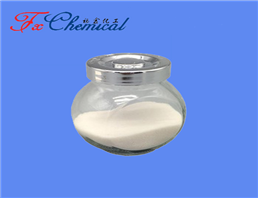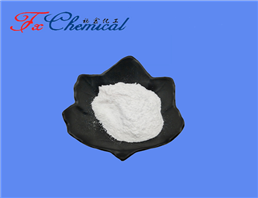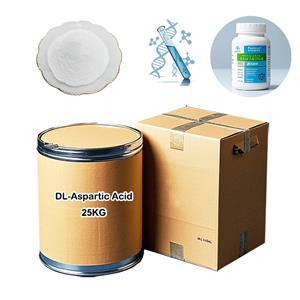
Product Details
| Product Name: D-Aspartic acid | CAS No.: 1783-96-6 |
| EC-No.: 217-234-6 | Min. Order: 1kg |
| Purity: 99%min AJI | Supply Ability: 1000kg |
| Release date: 2025/12/26 | |
| Type: SZ01 |
D-Aspartic acid Cas 1783-96-6
Specification
Items | Specifications | Results |
Appearance | White crystals or crystalline powder | Complies |
State of solution | ≥98.0% | 98.6% |
Specific Rotation | -24.0°~ -26.0° | -24.5° |
Chloride(Cl) | ≤0.02% | <0.02% |
Ammonium(NH4) | ≤0.02% | <0.02% |
Sulfate(SO4) | ≤0.02% | <0.02% |
Iron(Fe) | ≤10ppm | <10ppm |
Heavy metals(Pb) | ≤10ppm | <10ppm |
Arsenic(As2O3) | ≤1ppm | <1ppm |
Loss on drying | ≤0.20% | 0.13% |
Residue on ignition | ≤0.10% | 0.06% |
PH | 2.5~3.5 | 3.0 |
Assay | 99.0~101.0% | 99.5% |
Conclusion | The product by inspection accords with the standard of Enterprise Internal. | |
Welcome to contact with us to get more information.
D-Aspartic Acid (D-Asp) is one of the two stereoisomers of the amino acid aspartic acid. Its molecular formula is C₄H₇NO₄.
The "D-" designation is its most critical chemical feature. Like most amino acids, aspartic acid has a chiral center at its alpha carbon (the central carbon atom). This means it exists in two non-superimposable mirror-image forms: L-Aspartic Acid and D-Aspartic Acid.
L-Aspartic Acid: This is the form incorporated into proteins during ribosomal synthesis. It is one of the 20 standard proteinogenic amino acids and plays key roles in metabolism, such as the urea cycle and gluconeogenesis.
D-Aspartic Acid: This is the enantiomer (mirror image) of the L-form. Its spatial configuration is defined by its specific three-dimensional arrangement around the chiral alpha carbon. In the Fischer projection, the D-isomer has the amino group (-NH₂) on the right side.
Its core structure consists of:
An amino group (-NH₂) attached to the chiral alpha carbon.
A carboxyl group (-COOH) attached to the alpha carbon.
A side chain composed of a second carboxyl group (-COOH), which classifies it as a dicarboxylic, acidic amino acid.
Biochemical Synthesis and Occurrence
Unlike L-aspartic acid, D-Asp is not produced by the ribosome. Its presence in biological systems results from a process called racemization. The enzyme aspartate racemase catalyzes the conversion of L-Aspartic Acid to D-Aspartic Acid. It is found in various tissues across the body, with notably high concentrations in the brain, pituitary gland, pineal gland, and testes.
Key Biological Functions and Significance
D-Aspartic Acid is classified as a non-proteinogenic amino acid, but it is far from biologically inert. It acts as a novel neurotransmitter and neuromodulator and plays crucial roles in the endocrine system:
Neurotransmission in the Central Nervous System: D-Asp acts as a signaling molecule in the brain. It binds to the NMDA (N-Methyl-D-Aspartate) receptor, the very receptor named for its selective activation by this isomer. By modulating this receptor, D-Asp can influence synaptic plasticity, which is fundamental to learning and memory.
Endocrine Regulation (Hormone Release): This is one of its most significant roles.
In the Pituitary Gland: D-Asp stimulates the release of luteinizing hormone (LH), growth hormone (GH), and prolactin.
In the Testes: It accumulates in the testes' Leydig cells and promotes the synthesis and release of testosterone. It does this by upregulating the expression of the steroidogenic acute regulatory (StAR) protein and the enzyme cytochrome P450scc, which are critical for testosterone production. This function has made it a popular, though debated, dietary supplement for athletic performance and fertility.
Role in Development: Its levels are high during embryonic development, suggesting a role in the formation of the nervous system.
Summary
In essence, D-Aspartic Acid is the non-proteinogenic, D-enantiomer of aspartic acid. While it shares the same molecular formula as its L-form, its distinct three-dimensional structure allows it to function not as a building block for proteins, but as a specialized signaling molecule. It is an endogenous compound in humans and other animals, serving critical roles as a neuromodulator in the brain and a key regulator of hormone production in the endocrine system, particularly influencing reproductive hormones and growth.
Packages

Delivery

Payment term
* Wire Transfer/Telegraphic Transfer
* Western Union
* MoneyGram
* L/C
Contact information
Spring Zhang
Email: export@fortunachem.com
Skype: Fortunachem201304
QQ:3169620873
Tel: +86-27-59207892
Website: www.fortunachem.com
Company Profile Introduction
You may like
Recommended supplier
| Product name | Price | Suppliers | Update time | |
|---|---|---|---|---|
| $41.00/500mg |
VIP6Y
|
TargetMol Chemicals Inc.
|
2025-12-26 | |
| $1.00/1KG |
Shandong Xuhuang New material CoLTD
|
2025-02-21 | ||
| $5.00/1KG |
VIP5Y
|
Hebei Chuanghai Biotechnology Co,.LTD
|
2024-08-23 | |
| $50.00/1KG |
VIP3Y
|
Henan Fengda Chemical Co., Ltd
|
2023-12-22 | |
| $0.00/1kg |
Hebei Yanxi Chemical Co., Ltd.
|
2023-11-14 | ||
| $10.00/1Kg/Bag |
XI'AN TIANGUANGYUAN BIOTECH CO., LTD.
|
2023-07-06 | ||
| $200.00/25kg |
Henan Bao Enluo International TradeCo.,LTD
|
2023-05-15 | ||
| $0.00/1KG |
Hebei Chuanghai Biotechnology Co., Ltd
|
2022-09-29 | ||
| $25.00/1KG |
XINGTAI XINGJIU NEW MATERIAL TECHNOLOGY CO., LTD
|
2022-02-14 | ||
| $15.00/1KG |
Zhuozhou Wenxi import and Export Co., Ltd
|
2021-07-08 |
- Since: 2006-04-03
- Address: Room 2015, No.2 Building Kaixin Mansion, No.107 Jinqiao Ave, Wuhan, China
+8613986145403
info@fortunachem.com











 China
China